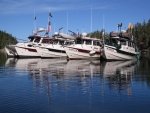1. The Water Speed through the tunnel on the 32 Cat.
The hulls on that cat are asymmetrical, not hull to hull but half to half on each hull, with both inside halves shaped differently than the outside halves It is really hard to see on the photos but looking at them in the factory it is visible.
2. The Air cushion affect.
The underside of the bridge deck, or the top of the tunnel is slopped down towards the water surface, effectively compressing the air as it goes through the tunnel which is providing some of the lift and smoothing the ride.
And the waterline "paint job " on that hull is really a piece of are in itself.
Michael's comment about running in 6 foot seas included that in that trip from Bellingham down to Seattle, there was rarely any sneezing due to the increased tunnel height and efficiency.
Colby, nice job on the photos there. It was great fun to get to meet there and to get to do that tour with you and Roseanne.
On the call to Vessel Traffic, The relevant channel varies depending on position. You did the right thing in calling to cross, especially if there is relevant traffic. When I call them, I also always ask to confirm that they see my AIS signal. That verifies to me that it is working, and also notifies other traffic in the area of my position. One other thing on VTS, I specifically wait until they are not busy. Sometimes they get very busy, and since I'm not commercial, I'm pretty low priority.
Harvey
SleepyC:moon



